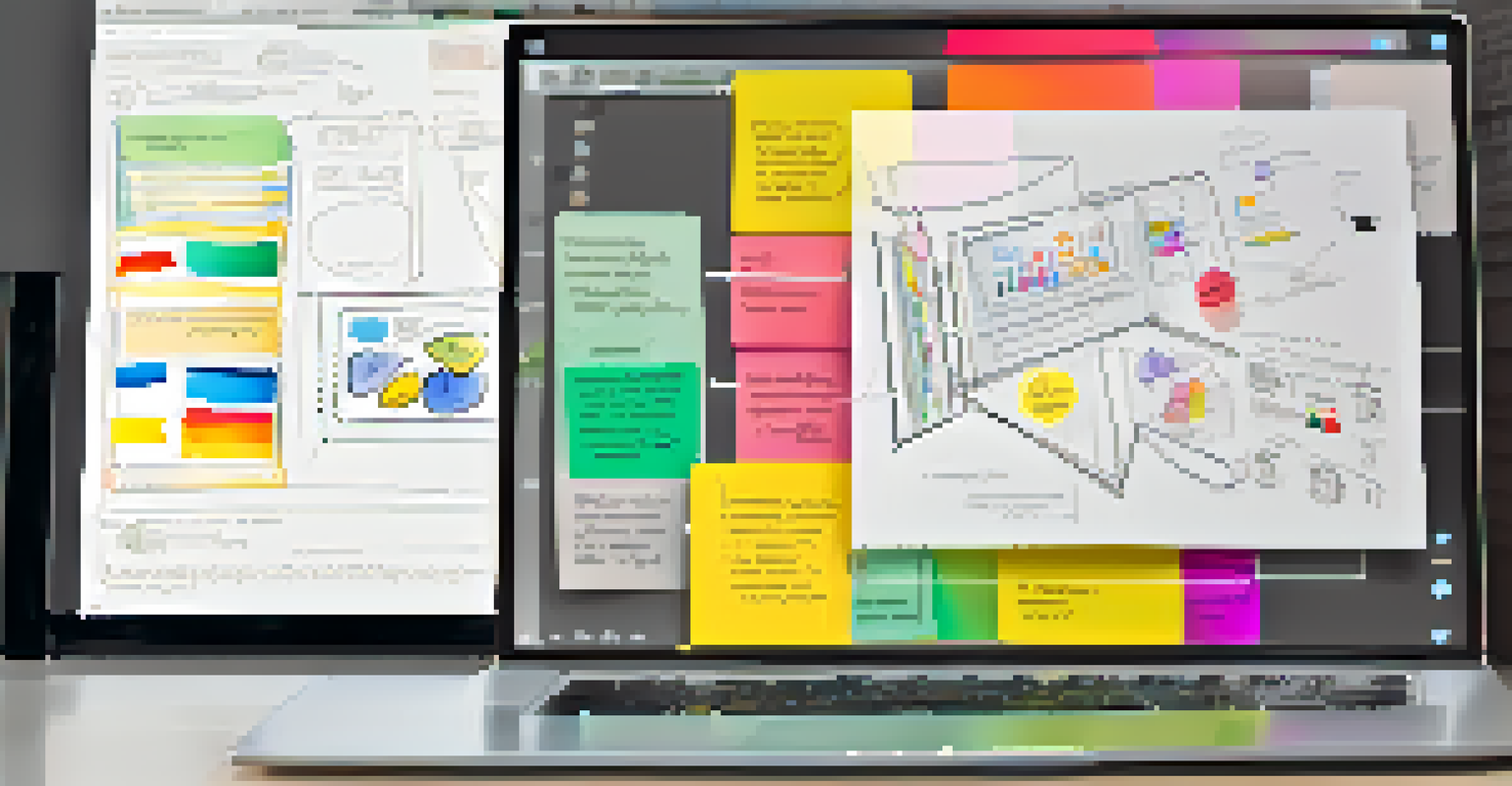The Role of Technology in Modern Product Development

Understanding the Foundation of Modern Product Development
Product development has evolved significantly over the years, shifting from traditional methods to more innovative approaches. Today, the process involves a blend of creativity and technology, allowing teams to bring ideas to life faster and more efficiently. This transformation has made it essential for businesses to understand the modern landscape of product development to stay competitive.
The greatest danger in times of turbulence is not the turbulence—it is to act with yesterday's logic.
In the past, product development often relied on lengthy cycles and extensive market research, which could slow down the launch of new products. However, with advancements in technology, companies can now leverage data analytics and customer feedback in real-time. This not only accelerates the development process but also ensures that products align closely with consumer needs.
Furthermore, technology enables collaboration across different teams and disciplines, breaking down silos that traditionally hindered progress. By fostering an integrated approach, businesses can innovate more effectively and respond to market demands swiftly. This is just the beginning of how technology shapes the future of product development.
The Role of Agile Methodologies in Product Development
Agile methodologies have revolutionized product development by promoting flexibility and iteration. This approach allows teams to adapt quickly to changes, ensuring that the final product meets user expectations. With technology facilitating agile practices, teams can pivot without losing momentum.

For instance, using tools like Jira or Trello, teams can manage tasks efficiently and visualize project progress. This transparency helps in identifying bottlenecks early, allowing for immediate adjustments. Consequently, products can be developed and refined through continuous feedback loops, enhancing their relevance in the market.
Technology Transforms Development
Modern product development leverages technology to enhance efficiency, creativity, and collaboration.
The heart of agile lies in its focus on collaboration and customer involvement. By actively engaging users throughout the development process, teams can create products that resonate with their target audience. This has proven to be a game-changer in achieving customer satisfaction and loyalty.
Leveraging Data Analytics for Informed Decision-Making
Data analytics plays a pivotal role in guiding product development decisions today. By harnessing vast amounts of data, teams can uncover insights about customer preferences, market trends, and potential challenges. This data-driven approach enables businesses to make informed choices rather than relying on gut feelings.
In a world where change is constant, the only way to stay relevant is to embrace it.
For example, businesses can analyze user behavior on their websites or apps to identify which features are most popular. This information can inform product enhancements and help prioritize features that matter most to users. As a result, companies can allocate resources more effectively and deliver products that truly resonate.
Moreover, predictive analytics can help forecast market shifts, allowing teams to stay ahead of the curve. By anticipating changes in consumer behavior, businesses can pivot their product strategies proactively, ensuring they remain relevant in a fast-paced environment.
The Influence of Prototyping Tools on Product Development
Prototyping tools have become invaluable assets in the modern product development toolkit. These technologies allow teams to create mock-ups or functional prototypes quickly, providing a tangible representation of ideas. This hands-on approach helps in visualizing concepts and facilitates better communication among team members.
For instance, tools like Sketch or Adobe XD enable designers to craft interactive prototypes that stakeholders can test. This immediate feedback loop allows teams to identify areas for improvement early in the process, reducing the risk of costly changes later on. By iterating through prototypes, teams can refine their designs based on real user interactions.
Agile Methodologies Boost Flexibility
Adopting agile practices allows teams to adapt quickly to changes, ensuring products meet user expectations.
Additionally, these tools often integrate with other technologies, like virtual reality, enhancing the prototyping experience. Such innovations not only save time but also foster creativity, enabling teams to explore new ideas without the constraints of traditional methods.
Enhancing Collaboration with Cloud-Based Platforms
Cloud-based platforms have transformed how teams collaborate in product development. These tools allow team members to access project files and communicate seamlessly from anywhere in the world. This flexibility is particularly crucial in today's remote working environment, where teams may be dispersed across various locations.
Platforms like Slack and Google Workspace facilitate real-time communication and document sharing, ensuring everyone is on the same page. This accessibility strengthens teamwork and helps maintain momentum throughout the development process. When everyone can contribute ideas and feedback instantly, the quality of the final product improves significantly.
Moreover, cloud storage solutions provide a central repository for project files, reducing the risk of version control issues. By having a single source of truth, teams can avoid confusion and ensure that all stakeholders have access to the latest information, streamlining the development workflow.
Embracing Automation to Streamline Processes
Automation has emerged as a key player in modern product development, streamlining repetitive tasks and freeing up teams to focus on innovation. By automating processes like testing, data entry, or project management, businesses can significantly reduce time spent on mundane activities. This efficiency not only accelerates the development cycle but also minimizes human error.
For example, automated testing tools can run countless scenarios in a fraction of the time it would take a human, ensuring that products are bug-free before launch. This allows developers to concentrate on enhancing features instead of getting bogged down by manual testing. As a result, product quality improves, leading to higher customer satisfaction.
Customer Feedback Drives Success
Integrating customer feedback throughout the development process leads to products that better align with user needs.
Additionally, automation tools can assist in project tracking, helping teams stay organized and accountable. By automating reminders and updates, teams can maintain focus and ensure that deadlines are met. This level of efficiency is essential in today’s fast-paced market, where speed and accuracy are paramount.
Integrating Customer Feedback for Continuous Improvement
Collecting and integrating customer feedback is crucial for successful product development. In the digital age, businesses have various channels to gather insights, from surveys to social media interactions. This feedback loop enables teams to understand user needs and preferences, making it an integral part of the development process.
For instance, user testing sessions provide invaluable insights into how customers interact with a product. Observing real users can reveal pain points that may not have been apparent during the initial development stages. By incorporating this feedback, teams can make necessary adjustments and ensure the final product meets user expectations.

Moreover, fostering a culture of feedback encourages open communication between teams and their customers. This not only helps in refining existing products but also inspires new ideas for future developments. Ultimately, prioritizing customer input leads to stronger products and happier users.
The Future of Product Development: A Tech-Driven Landscape
As we look ahead, the role of technology in product development is only expected to grow. Emerging technologies like artificial intelligence, machine learning, and blockchain are set to further revolutionize how products are conceived, developed, and launched. These innovations promise to enhance efficiency and create even more personalized experiences for users.
For instance, AI can analyze vast datasets to identify trends and predict future consumer behavior, enabling teams to develop products that are more aligned with market demands. Similarly, blockchain technology can enhance transparency in supply chains, ensuring product authenticity and trustworthiness. As these technologies continue to evolve, they will undoubtedly reshape the product development landscape.
In conclusion, embracing technological advancements is not just an option for businesses today; it's a necessity. Companies that adapt and integrate these tools into their development processes will be better positioned to thrive in an increasingly competitive market. The future of product development is bright, and technology will play a pivotal role in driving innovation.